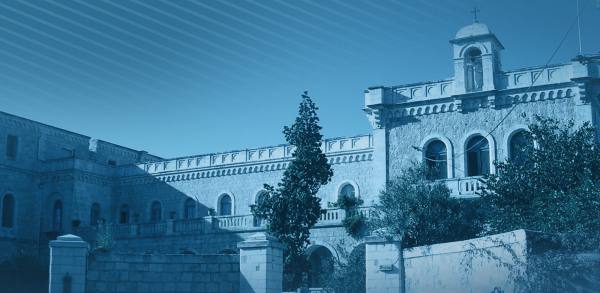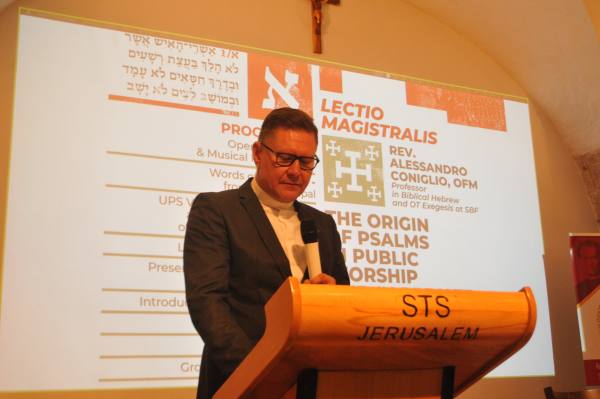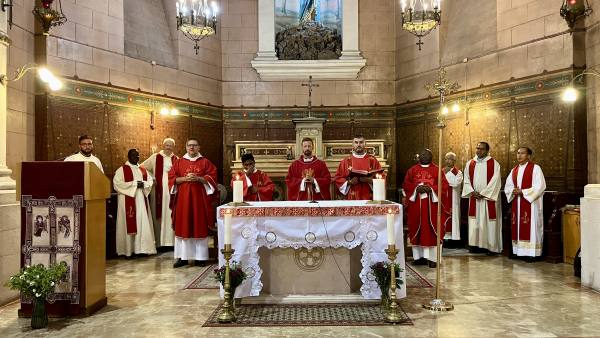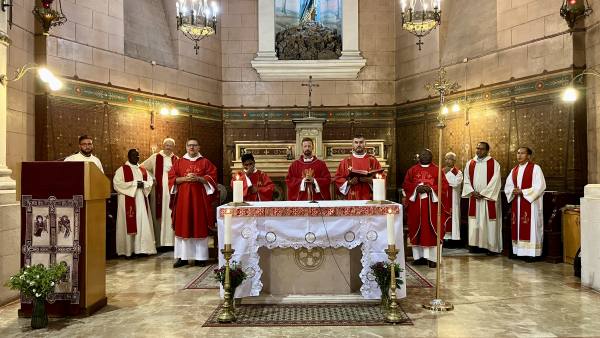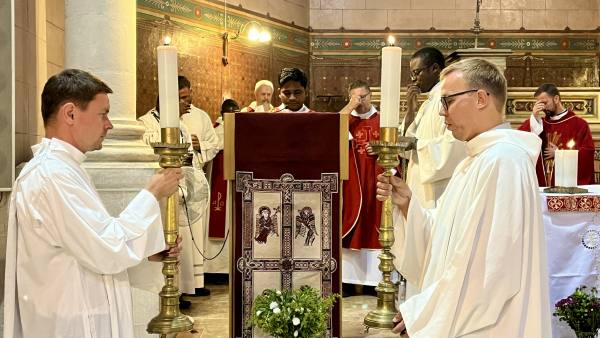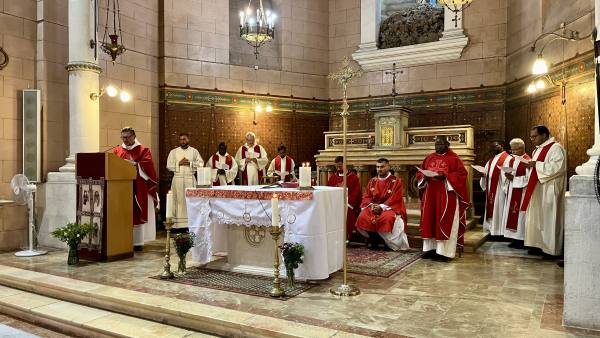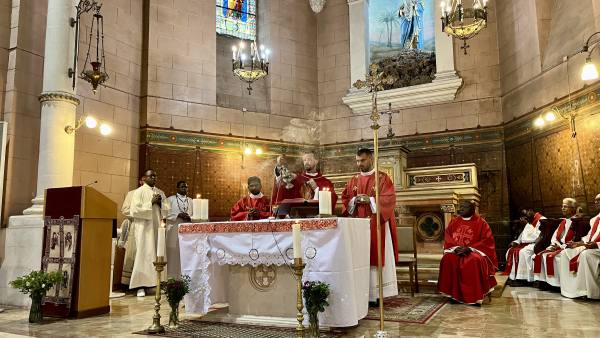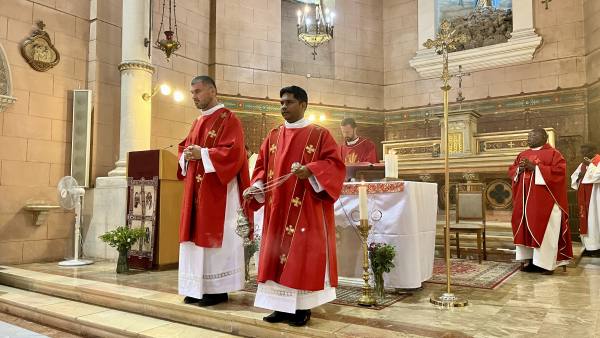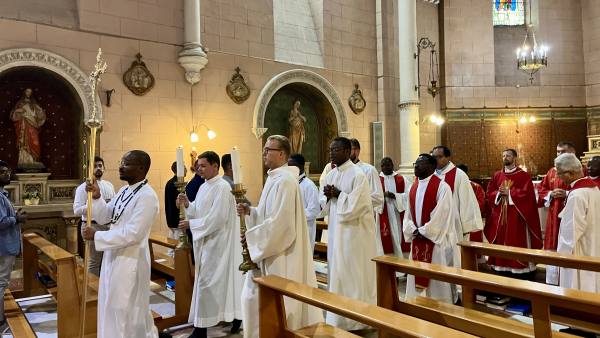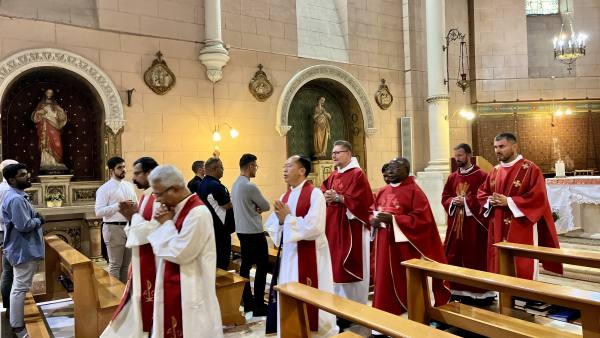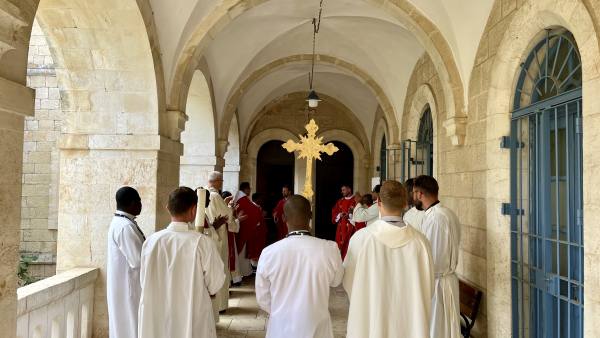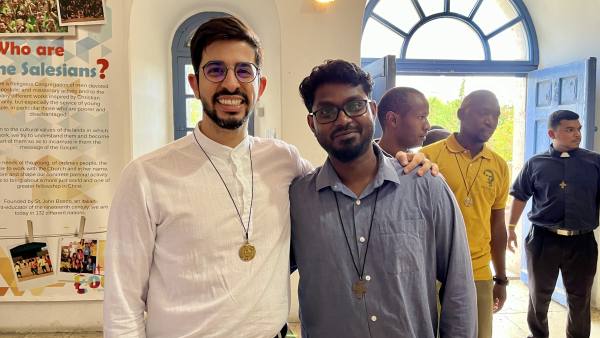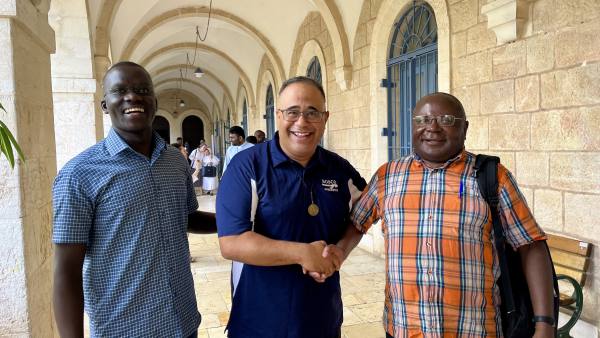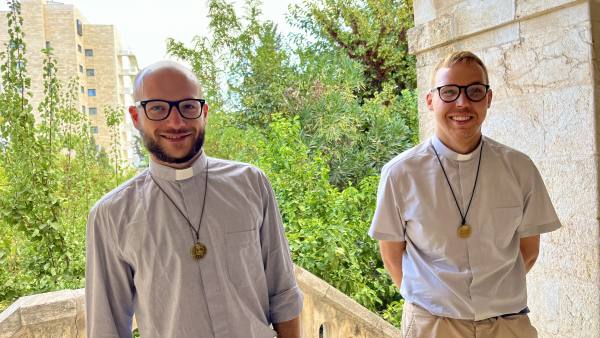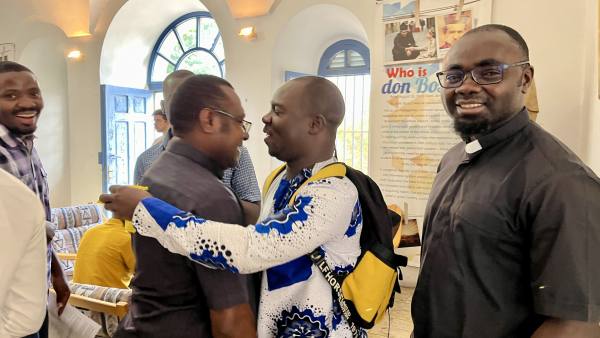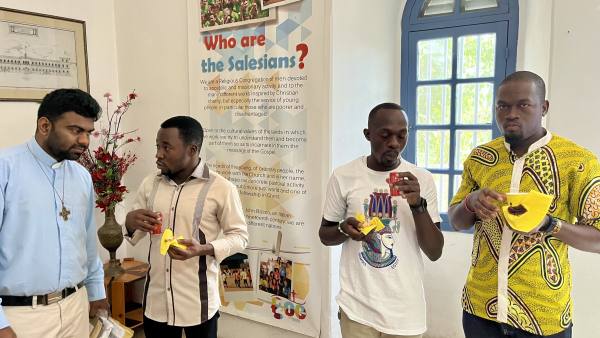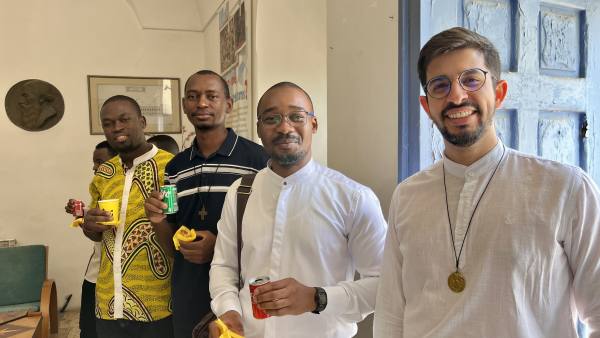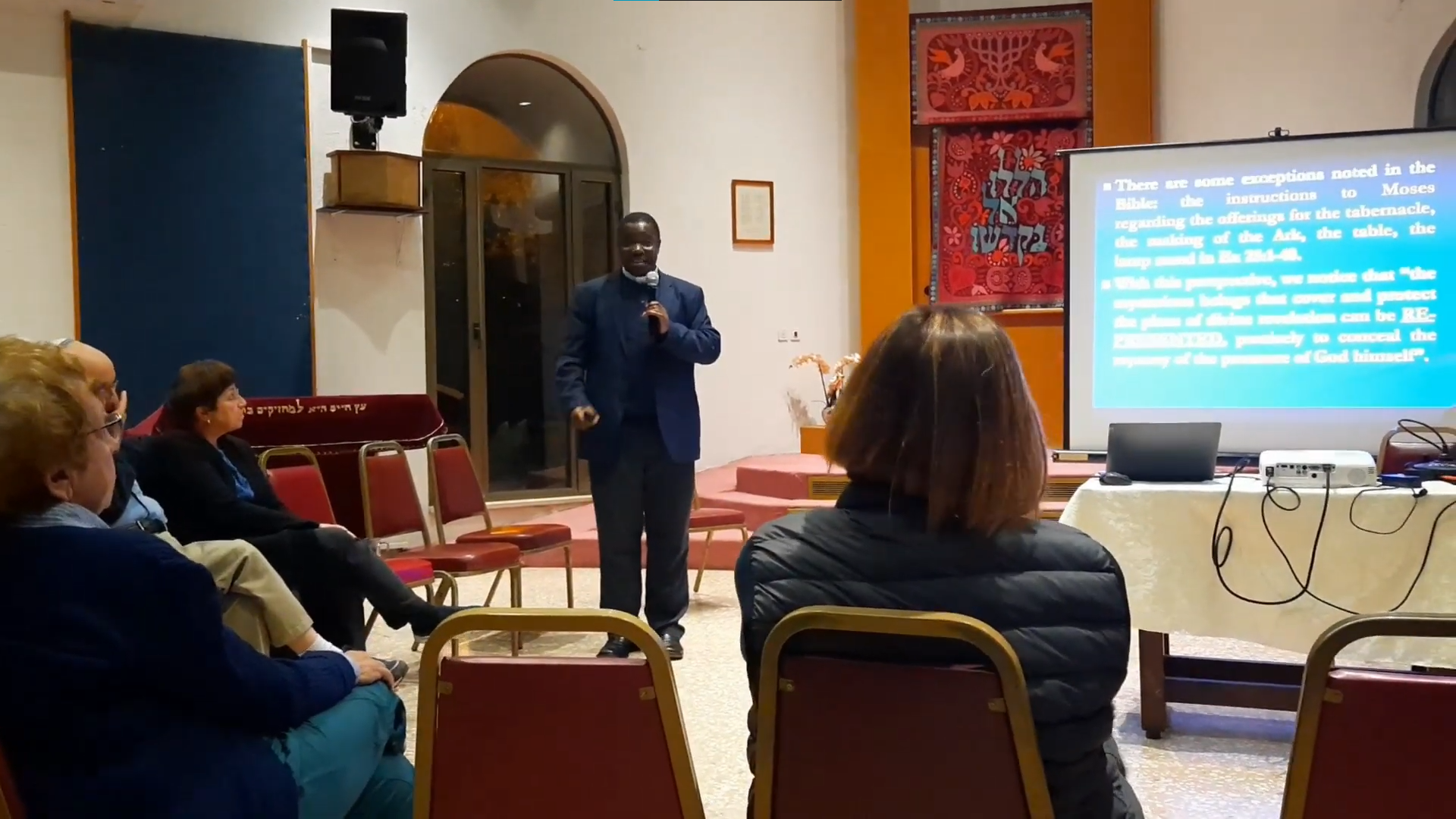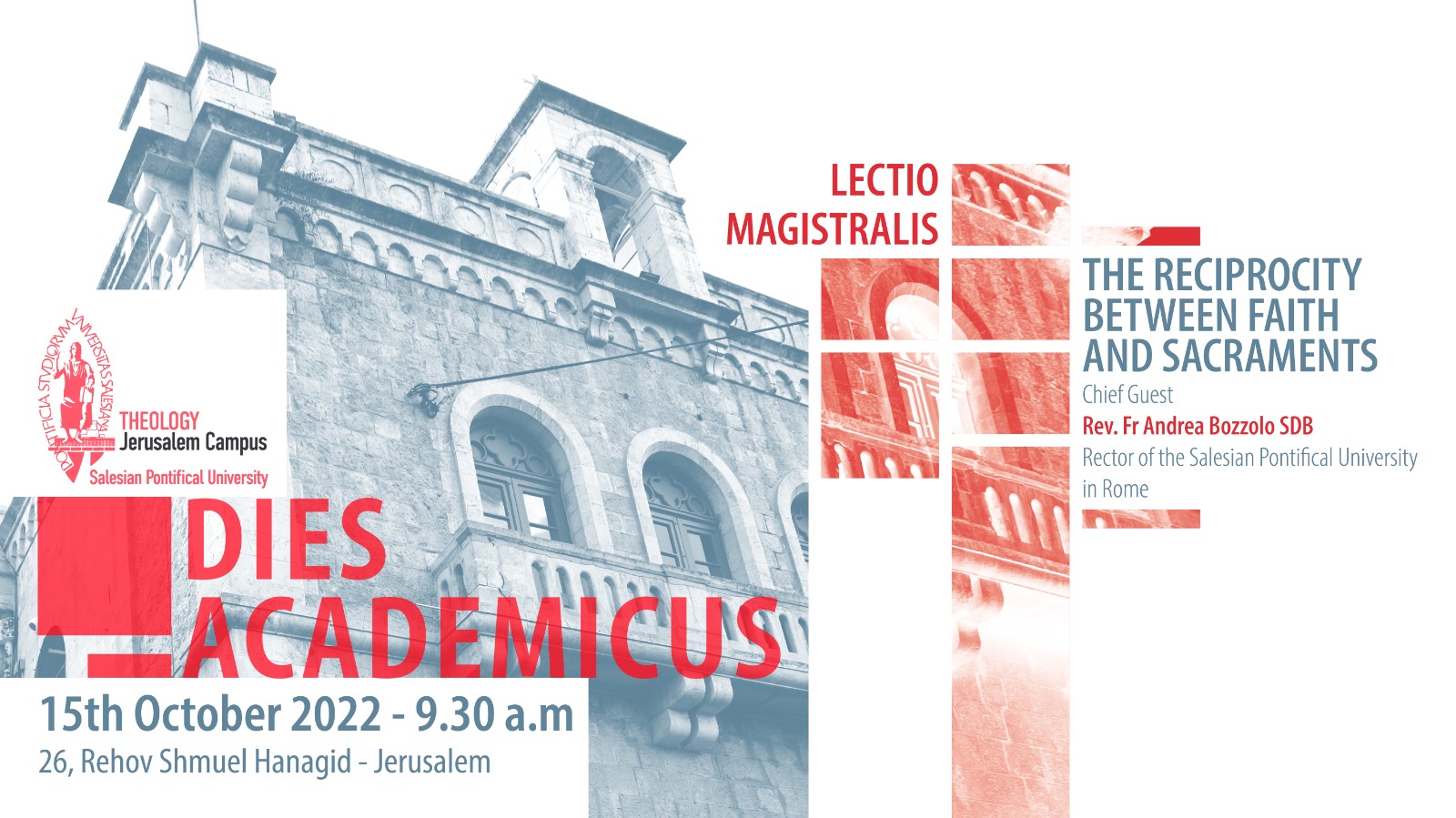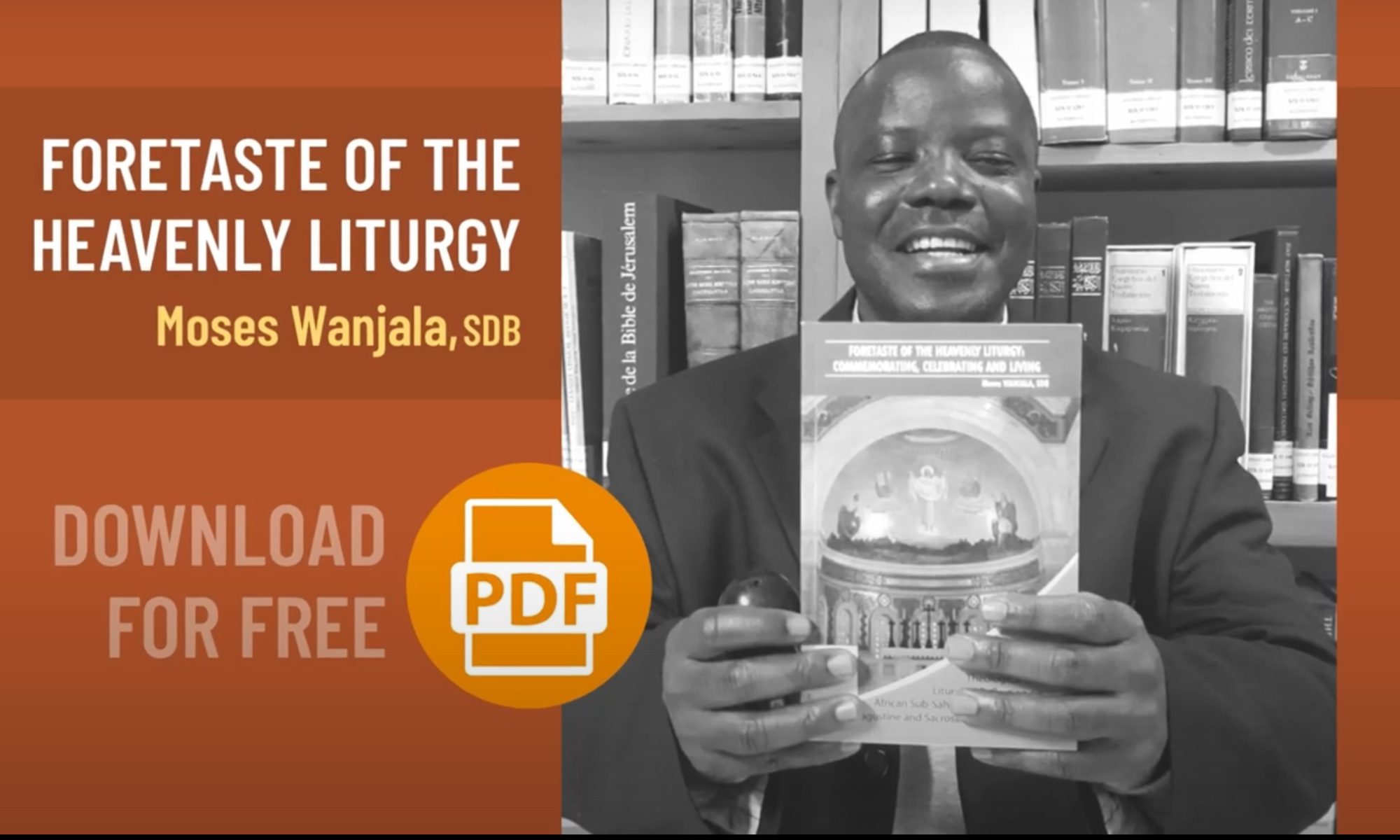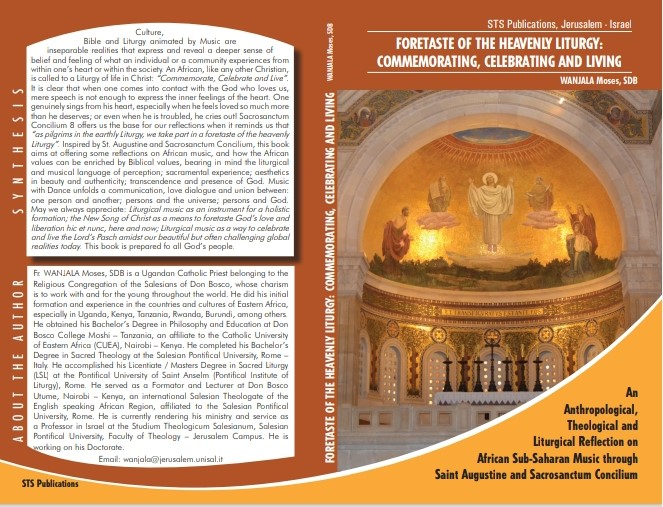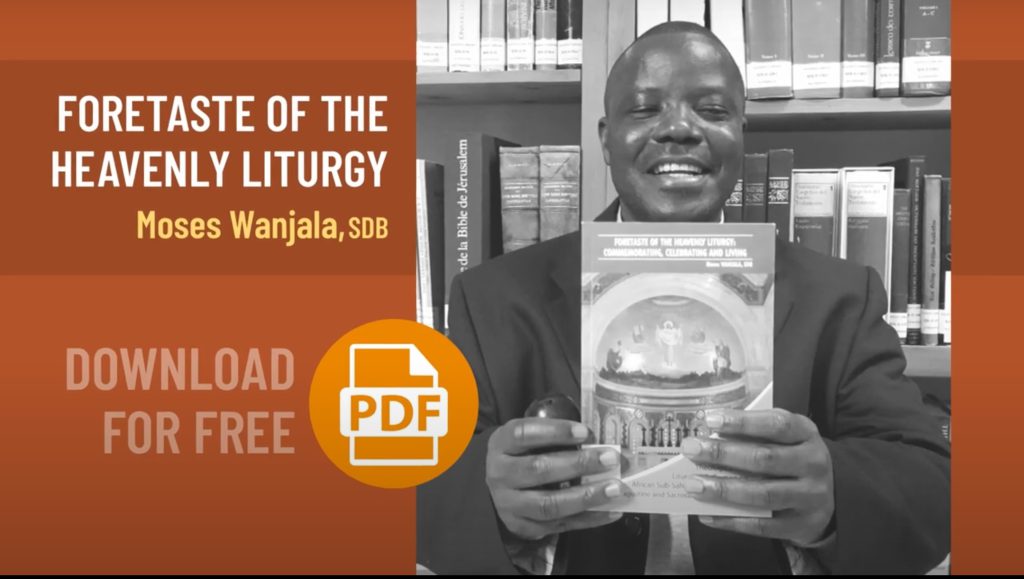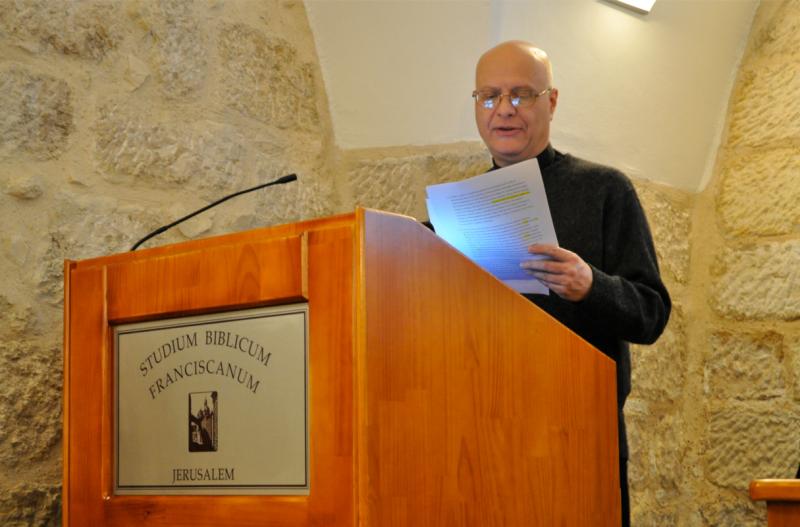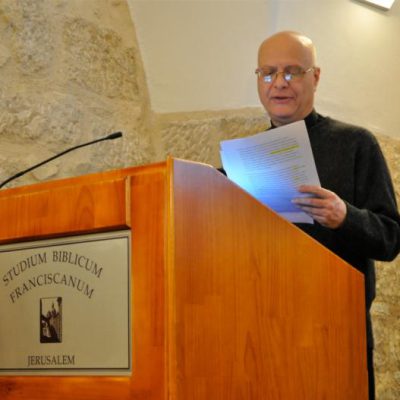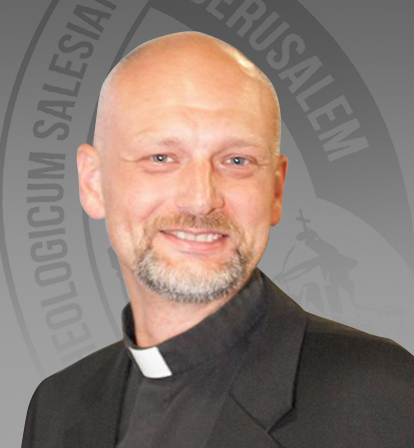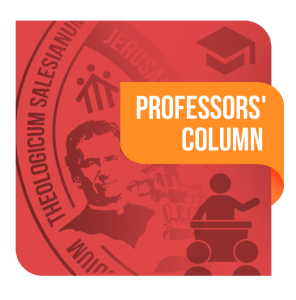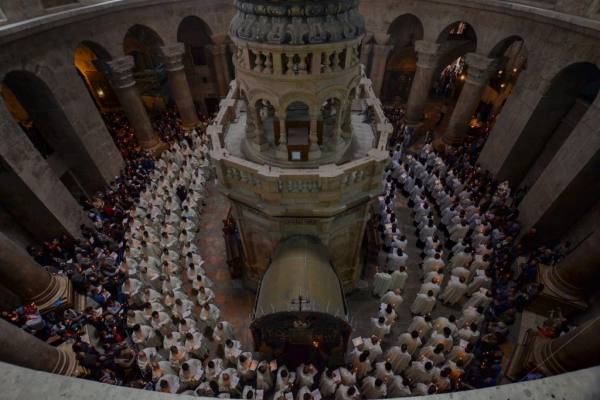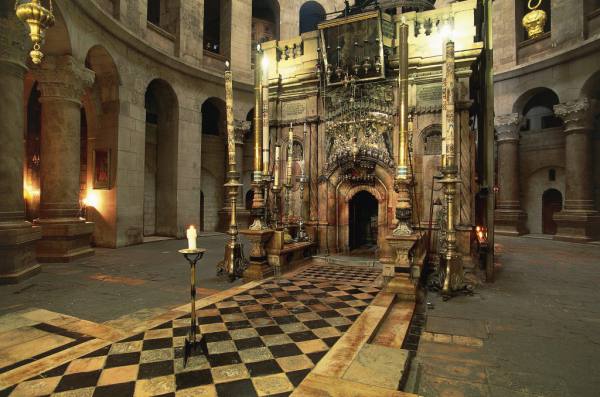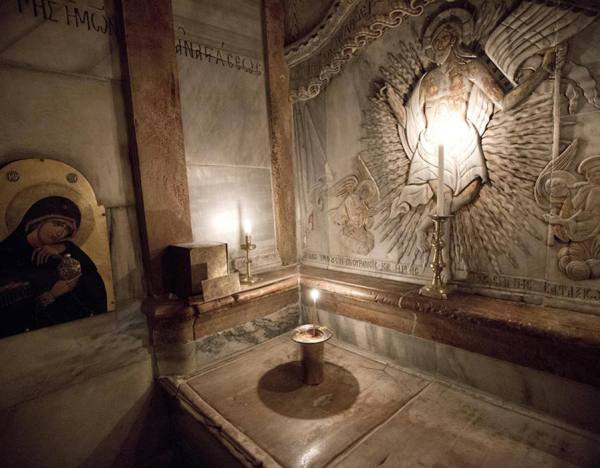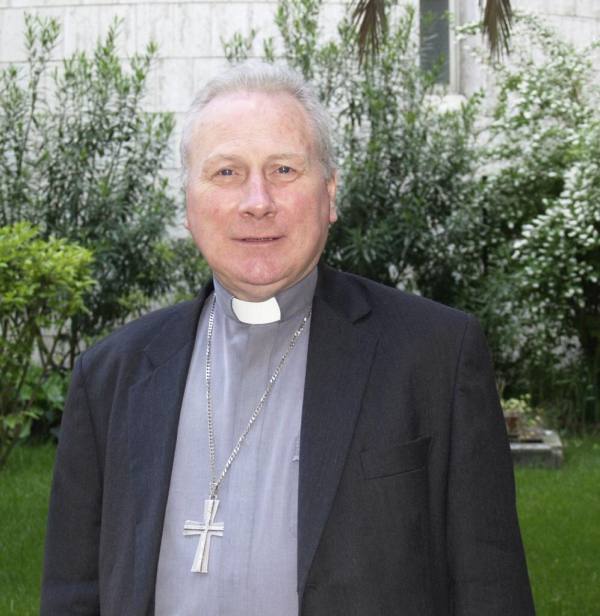FRUCTUM DABIT; Planting Seeds of Hope and Creating a Culture of Dialogue.
First, I wish to express my gratitude to the President of the STS for his invitation to speak to you on the occasion of the opening of the second semester of this strange year. It would have been more pleasant to have been among you physically, but we are all getting used to distancing, and we thank God for the technology that keeps us linked.
It would have been difficult to refuse the invitation, particularly since the topic to be addressed was cunningly formulated to begin with my episcopal motto, Fructum Dabit. So let me explain first where this motto comes from and what it means for me.
The words come from the second strophe of Psalm 1. In the Jerusalem Bible version it reads as follows:
He is like a tree that is planted
by water streams
yielding its fruit in season. its
leaves never fading;
success attends all he does.
The full Latin version of the third line is fructum dabit in tempore suo. I wished to take this expression as my motto, but I was told it was too long. The words missed out have to be understood, as they are important as I shall explain.
That which “will give fruit” (you will have recognized the future tense of dabit, even though in the JB it is translated by an active participle) is a tree planted by running water. When in 1992 I was made a bishop by Pope Saint John Paul II I was given as a titular see Nepte. Nepte is the ancient name for Nefta, in Tunisia, which is an oasis famous for its date palms. So the fruit-bearing tree recalls my diocese.
The psalm says: “He is like a tree”. The “he” refers to the just man “who never follows the advice of the wicked” (Ps 1:1). In referring to this fruit-bearing tree I was assuredly not thinking of myself, but rather of the process of dialogue to which my whole missionary life has been dedicated.
When you plant a date-palm you cannot expect to get fruit from it immediately. You have to wait until the palm-tree matures. It will bear fruit, but in season, in its own good time. This for me is an excellent symbol of interreligious dialogue. When you engage in dialogue you cannot expect to see fruits immediately. You have to allow the fruits to develop in their own good time. You have to be patient. So dialogue is an activity to be engaged in with much patience, but also with great hope, because you know that the fruit will come.
It is in this spirit that we shall now turn to Fratelli Tutti, to see how it is planting seeds of hope and contributing to create a culture of dialogue.
Pope Francis, in his encyclical letter Fratelli Tutti, is presenting a broad vision of the future where “the barriers of geography and distance” are transcended, in which every person “regardless of physical proximity, regardless of where he or she was born or lives” (1) is concerned. This is surely intended by the “Tutti” of the title. Moreover the Pope has a universal readership for his letter in view, for he says in the introduction:
Although I have written it from the Christian convictions that inspire and sustain me, I have sought to make this reflection an invitation to dialogue among all people of good will (6).
As an example of transcending barriers reference is made at the beginning of the letter to the visit of St Francis of Assisi, whom the Pope chose as the Patron for his pontificate, to the Sultan Malik al-Kamil, a visit carried out during the Crusades, across the borders of warring factions, a visit full of respect by a Christian to one who was considered an infidel and an enemy (cf.3). Dialogue, as a border-crossing activity, is something that Pope Francis himself is engaged in, following the example of St Francis. He has developed a friendship with a Muslim leader, Dr Ahmad al-Tayyeb, the Grand Imam of al-Azhar. It is interesting to note that the Pope says that just as he drew inspiration from Patriarch Bartholomew of Constantinople for the preparation of his previous encyclical, Laudato Si’, in writing this letter on “Fraternity and social friendship” he has felt encouraged by Dr Al-Tayyeb with whom, on 4 February 2019, he had signed the document on Human Fraternity for World Peace and Living Together (cf.5). At the end of Fratelli Tutti he pays tribute to others who have inspired him and who are not Catholics, mentioning in particular Martin Luther King, Desmond Tutu, Mahatma Gandhi (cf. 286).
Though Fratelli Tutti is long (287 paragraphs, 140 pages in the Catholic Truth Society edition), it does not claim to offer “complete teaching on fraternal love” but only “a modest contribution to continued reflection” in the hope of arousing “a new vision of fraternity and social friendship” (6). We could surely say that Pope Francis is sowing seeds of hope.
I would say that Pope Francis is issuing to all of us a wake-up call. He is a dreamer – his book written in conversation with Austin Ivereigh is entitled Let Us Dream – but he does not live in a dream world. He is a realist. The first chapter of Fratelli Tutti, “Dark Clouds over a Closed World” gives a sombre picture of the world we live in. Because there is an emphasis on promoting individual interests, we tend to feel alone (12). Because also there has been a loss of historical consciousness, we have lost touch with our roots (13). This leaves us more vulnerable. A tree that has strong roots going deep underground can withstand the storm. We know that when trees have been cut down landslides take place, landslides which sweep everything away. Perhaps this very fragility weakens our respect for nature and for the gifts of nature. We are tempted to use everything as quickly as possible, and then to jettison it when it is exhausted. So we find ourselves in what Pope Francis describes as “a ‘throwaway’ world”, where it is not only material goods, even food, that is thrown away, but also people who are rejected as being useless (19). Already in the introduction Pope Francis had referred to the Covid-19 pandemic which, he says, has exposed our false securities (7). We have all been shaken by this storm and, as he said in his solitary prayer for an end to the pandemic: “We are all in the same boat together”. All this can lead to discouragement and despair. Yet Pope Francis ends this chapter with two paragraphs on hope.
He speaks of “new paths of hope”, going on to explain that “God continues to sow abundant seeds of goodness in our human family” (54). We have seen this in the generous response of so many to the pandemic. Hope, he adds “speaks to us of something deeply rooted in every human heart…of a thirst, an aspiration, a longing for a life of fulfilment, a desire to achieve great things, things that fill our heart and lift our spirit to lofty realities like truth, goodness and beauty, justice and love” (55).
Everything is connected. We humans are all connected. We belong to one human family. Chapter 2 of Fratelli Tutti, “A Stranger on the Road” is a long reflection on the well-known parable of the Good Samaritan.
Although this Letter is addressed to all people of good will, regardless of their religious convictions, the parable [told by Jesus and at the heart of the Gospel] is one that any of us can relate to and find challenging (56).
This parable can be considered an illustration of inter-connectedness. Francis invites us to consider the characters in the parable and ask ourselves “with which persons do I identify?” I will leave you to do this for yourselves. I wish only to call attention to the inn-keeper. The Samaritan does not try to do everything on his own. He links up with the inn-keeper, promising to pay for the unexpected guest, and the inn-keeper would appear to have trusted this benefactor. We can ask ourselves: Are we ready to cooperate with other people, even if they do not belong to our race or religion, or our social standing? Are we able to create a climate of trust that can lead to cooperation? Such trust is bred by faith, for
faith has untold power to inspire and sustain our respect for others, for believers come to know that God loves every man and woman with infinite love and thereby confers infinite dignity upon all humanity (85).
I would be inclined to add a further question from the perspective of inter-faith dialogue: Are we ready to move from a “dialogue of life”, where people strive to live in an open and neighbourly spirit, sharing their joys and sorrows, their human problems and preoccupations, to a “dialogue of action”, collaborating to find solutions to these problems and to improve the conditions of life? It is noteworthy that Jesus, after having told this parable, does not ask “Who is the neighbour?” but “Which one proved to be a neighbour?” As Pope Francis points out, the parable is advocating “neighbourliness without borders” (cf. the title before paragraph 80), a true fraternal spirit which is not seeking to satisfy its own interest but is searching for the common good.
In Fratelli Tutti Pope Francis is presenting a vision of how the world should be, a world of universal brotherhood, but he is not proposing to us that we should just wait for it to come, rather he is telling us to be active so that this fraternity and social friendship may be achieved. This is the purpose of chapter three “Envisaging and Engendering an Open World”.
Allow me to be pedantic for a moment. This title uses two active participles, and the active participle, certainly in Arabic but I think also in other languages, denotes an incomplete action, which can be present but also future. Here we have “Envisaging”, because we have to have a clear idea of what we want; and “engendering”, because our actions produce effects, whether negative or positive. Both envisaging and engendering are needed. An artist may have a clear idea of the subject he or she wishes to portray, but if no paint is put on the canvas there will be no picture.
Pope Francis reminds us that growth depends on relationships. Our self-consciousness develops through encounter with others. This holds good for individual persons, and at every stage of their existence, from infancy to old age. It holds good for married couples and for families, for societies, including religious congregations and societies, and it holds good for the Church itself. The challenge is to move beyond oneself. The enemy of growth is self-centredness, which closes the horizon. I am reminded of something that I think Saint-Exupéry wrote: that true love is not when two people are gazing into each other’s eyes but when they are looking together in the same direction.
Fratelli Tutti insists on love as the inspiration for all our actions, as the foundation of our relationships. Pope Francis asks us to examine whether our actions “foster openness and union with others” (91)? He goes on to say that love is “more than just a series of benevolent actions” (94). It implies a fundamental underlying attitude: the acceptance of others and, more than that, appreciation of their values, and so esteem for their persons. It includes benevolence, wishing the good of others – as you well know, in Italian ti voglio bene is a way of saying “I love you”. This makes possible a social friendship “that excludes no one and a fraternity that is open to all” (94).
Such social friendship is not easy, because we are always tempted to set limits, to create defensive boundaries, whether of class or creed, of religion or race. Here Pope Francis uses a telling phrase which we can understand more readily as we struggle with the effects of COVID-19: “Racism is a virus that quickly mutates and, instead of disappearing, goes into hiding, and lurks in waiting” (97).
Pope Francis goes on to speak about Liberty, Equality and Fraternity (people from France, pay attention). He says in effect that, in order to produce genuine fruit, Liberty and Equality need Fraternity. A “shallow understanding” of liberty, reduced to the freedom “to choose to whom or what we will belong” is far from “the richness of a liberty directed above all to love” (103). Equality is seen, not as an abstract proclamation that all are equal, but as “the result of the conscious and careful cultivation of fraternity” (104). In other words, true liberty and equality are incompatible with individualism, and here Pope Francis reuses forcefully the metaphor of the virus: “Radical individualism is a virus that is extremely difficult to eliminate” (105).
The best medicine against individualism is a spirit of solidarity. This leads to service and care for the most vulnerable. In a previous paragraph Pope Francis had spoken about “hidden exiles”, people “treated as foreign bodies in society” (98). Amongst these he includes people with disabilities, and also the elderly. The importance that Francis gives to the elderly, not only in this encyclical but in his teaching generally, is really striking; perhaps I notice this more as I belong myself to this category of persons. Francis sees the elderly as witnesses of a past history which provides roots, and thus gives stability to society. If we wish to face up to the future with courage, it is good to know where we have come from. I think we could apply this to our religious bodies, where the younger members can learn from their elders. It is good to know the history of how a charism has been formulated, then accepted and adapted to different circumstances.
I digress. Let me return to Fratelli Tutti. This letter reminds us that true solidarity does not consist merely in sporadic acts of generosity.
It means thinking and acting in terms of community…. It also means combatting the structural causes of poverty, inequality, the lack of work, land and housing, the denial of social and labour rights. It means confronting the destructive effects of the empire of money” (116).
Francis returns to this at the end of this chapter where he notes that, “if we accept the great principle that there are rights born of our inalienable human dignity, we rise to the challenge of envisaging a new humanity. We can aspire to a world that provides land, housing and work for all” (127). Here Francis is referring to the three ‘T’s in Spanish: tierra, trabajo, techo, which become the three ‘L’s in English: Land, Labour, Lodging. To give effect to this implies accompanying people, “not only by providing for their basic needs, but by enabling them to give the best of themselves, even though their performance may be less than optimum, their pace slow or their efficiency limited” (110).
We need to go further, realizing that concern for humanity as a whole implies caring for our common home, we should take to heart the teaching that the riches of the earth, the soil and the sea, have a common destination. Here we would need to re-read Laudato Si’ and reflect on how the lessons it contains can be put into practice.
With regard to the application of the principle of the common destination of the earth’s goods, Pope Francis opens up a much wider perspective. A firm belief in this principle requires that it also be applied to nations, their territories and their resources. “This presupposes a different way of understanding relations and exchanges between countries” (120). Consequently, no one is a stranger, all people are brothers and sisters and are to be treated as such.
The scene thus broadens as, in chapter four, Pope Francis encourages us to have “A Heart Open to the Whole World”. It is one of the shortest sections of the letter, yet it touches on important points. There is the question of migration. “Ideally, unnecessary migration ought to be avoided.” Rendering it “unnecessary” would entail “creating in countries of origin the conditions needed for a dignified life and integral development.” But there is no denying reality; the phenomenon of migration is ever-present. Consequently there is the need for a response summed up by Pope Francis, here as elsewhere, in four words: “welcome, protect, promote, integrate” (129).
Yet integration involves the further question of citizenship. This question had already been broached in the Document on Human Fraternity. There, as here, the concept of full citizenship was invoked (131), but this surely needs further explanation. Similarly with the idea of cultural exchanges, for example between East and West (136), again mentioned already in the Document on Human Fraternity; one might ask what exactly is meant by ‘the East’. Whatever may be the answer to that question, there is no denying the need “to communicate with each other, to discover the gifts of each person, to promote that which unites us, and to regard our differences as an opportunity to grow in mutual respect” (134). This is said of individuals, but it is valid also for nations: “mutual assistance between countries proves enriching for each… We need to develop the awareness that nowadays we are all saved together or no one is saved” (137). Yet the spirit governing such communication and exchange should be one of ‘gratuitousness’, “the ability to do some things simply because they are good in themselves, without concern for personal gain or recompense” (139).
Finally this chapter emphasizes the need to combine the global and the local: attention to the global dimension is a way of avoiding “narrowness and banality” and “petty provincialism”; involvement with the local scene helps us to keep “our feet on the ground”; local action is “capable of being a leaven” (142), another image for producing a future effect, to be added to that of the seed that is sown.
Some have criticized Pope Francis for writing a social encyclical which, they say, is far from the teaching of the Gospel. Yet if one reads Fratelli Tutti carefully one will see that there are many references to God and also that we are invited to look beyond the surface to the hidden side of reality. This is true when political activity is being considered. The Pope is not engaging in party politics, but rather stressing the need for A Better Kind of Politics (the title of chapter five). He is advocating political activity which is “truly at the service of the common good” (154) and which “makes room for everyone, including the most vulnerable” (155).
From this perspective we find in the encyclical a discussion on the notion of “people” which, says Pope Francis, has “a deeper meaning that cannot be set forth in purely logical terms” (158). This theme is also taken up in the book Let Us Dream. In the encyclical it is stated that “to be part of a people is to be part of a shared identity arising from social and cultural bonds” (158). So people means much more than just a group of persons. The Pope assures us that:
A living and dynamic people, a people with a future, is one constantly open to a new synthesis through its ability to overcome differences (160).
The notion of “work” has also hidden depths. It is “not only a means of earning one’s daily bread but also of personal growth”. Consequently providing work for people, “to provide everyone with the opportunity to nurture the seeds that God has planted in each of us” (162), is in fact offering the possibility of shared responsibility, thus enhancing dignity.
There are other hidden realities including underlying human weakness, or “the proclivity of selfishness”, but this weakness can be overcome with the help of God. It is with this help that people can achieve the needed “change of heart, attitudes and lifestyles” (166). “Education and upbringing, concern for others, a well-integrated view of life and spiritual growth: all these [ which, I might add, are promoted here at the STS] are essential for quality human relationships and for enabling society itself to react against injustices, aberrations and abuses of economic, technological, political and media power” (167). This education is obviously to be offered to individuals, but it is also provided through movements and associations. Such movements and associations are sometimes treated with suspicion, because, as the encyclical notes, “they may be troublesome”, but it should be recognized that they are capable of being “sowers of change, promoters of a process involving millions of actions, great and small, creatively intertwined like words in a poem”; Francis calls them “social poets” (169).
In turning to the global scene, Fratelli Tutti points to weaknesses here too:
“In the face of many petty forms of politics focused on immediate interests, I would repeat that ‘true statecraft is manifest when, in difficult times, we uphold high principles and think of the long-term common good’ (178)
It goes on:
Global society is suffering from grave structural deficiencies that cannot be resolved by piecemeal solutions or quick fixes. Much needs to change, through fundamental reform and major renewal (179).
I would interject here that Pope Francis is well aware that it is not possible to have recourse to “quick fixes”. Right from the beginning of his pontificate he aimed to reform the Roman Curia, the services which help the Pope in governing the universal Church. After seven years of study and reflection the new statutes of the Curia are still to be published. Pope Francis has been encouraging a “fundamental reform” of the attitudes of the people working in the Curia. He is convinced that the style of work, of service, will flow from this change of attitude.
To return to the global perspective, one in which we are all involved, Pope Francis is calling for “political charity”. This may surprise us. People today seem to have lost confidence in politics, seeing it merely as a way that some persons press their own advantage or achieve their own personal prestige. Yet:
political charity is born of a social awareness that transcends every individualistic mindset: Social charity makes us love the common good, it makes us effectively seek the good of all people, considered not only as individuals or private persons, but also in the social dimension that unites them (182).
As priests and religious we are not normally engaged in politics, but we may well have to encourage and counsel people who are so engaged. In this respect the teaching of Pope Francis on “political charity” will be a source of enlightenment.
Francis continues by saying that “‘social love’ makes it possible to advance towards a civilization of love, to which all of us can feel called. Charity, with its impulse to universality, is capable of building a new world” (183). Here he is building on the teaching of his predecessors, in particular Paul VI and John Paul II. He draws also on the encyclical of Benedict XVI, Caritas in Veritate, “Charity in Truth”, saying that the recognition of truth prevents charity from being merely subjective, from being confined to a narrow group of people, opens it up to the advancements of science so that the best means of progress may be chosen. This leads to the conclusion that “this charity, which is the spiritual heart of politics, is always a preferential love shown to those in greatest need; it undergirds everything we do on their behalf” (187).This is not just abstract talk. The same paragraph goes on to say:
only a gaze transformed by charity can enable the dignity of others to be recognized and, as a consequence, the poor to be acknowledged and valued in their dignity, respected in their identity and culture, and thus truly integrated into society. That gaze is at the heart of the authentic spirit of politics. It sees paths open up that are different from those of a soulless pragmatism. It makes us realize that “the scandal of poverty cannot be addressed by promoting strategies of containment that only tranquilize the poor and render them tame and inoffensive (187).
Accordingly “to tend to those in need takes strength and tenderness, effort and generosity” (188); it requires “a spirit of openness to everyone” (190).
This leads to a “culture of tolerance” (192), something which the Grand Imam of al-Azhar and Pope Francis had already mentioned in their joint Document on Human Fraternity. This is something that would need to be spelt out further.
In Fratelli Tutti Pope Francis turns to politicians as persons. He explains that the tenderness he has been talking about is “love that draws near and becomes real…Tenderness is the path of choice for the strongest, most courageous men and women” (194). He reminds politicians that they are called “to practise love in their daily interpersonal relationships” (193).
If the results are not seen immediately, this is no reason for giving up. Pope Francis turns again to hidden reality: “it is truly noble to place our hope in the hidden power of the seeds of goodness we sow” (195). We can ask ourselves whether we bear witness to this hidden reality: do we see and appreciate the signs of God’s presence in our midst?
This chapter of Fratelli Tutti ends with a series of questions which, even though they are put to politicians, we can all take up. They can serve us as a canvas for a serious examination of conscience:
“At times, in thinking of the future, we do well to ask ourselves, ‘Why I am doing this?’, ‘What is my real aim?’ For as time goes on, reflecting on the past, the questions will not be: ‘How many people endorsed me?’, ‘How many voted for me?’, ‘How many had a positive image of me?’ The real, and potentially painful, questions will be, ‘How much love did I put into my work?’ ‘What did I do for the progress of our people?’ ‘What mark did I leave on the life of society?’ ‘What real bonds did I create?’ ‘What positive forces did I unleash?’ ‘How much social peace did I sow?’ ‘What good did I achieve in the position that was entrusted to me?’ “(197)
Pope Francis recognizes that the planter of seeds may have to wait a long time to see the fruit of his work; he is not looking for quick fixes, but is ready for the long haul. So, in chapter six of Fratelli Tutti, he discusses “Dialogue and Friendship in Society”. “Approaching, speaking, listening, looking at, coming to know and understand one another, and to find common ground: all these things are summed up in the one word ‘dialogue’ “ (198). This is how this chapter starts, descriptively, rather than with a definition of dialogue.
Dialogue can be very public, for instance in peace negotiations, but it can often be rather hidden. As Pope Francis says: “persistent and courageous dialogue does not make headlines” (198). The break-up of a marriage, leading to divorce, especially of celebrities, is “news”, but the patient dialogue that keeps a marriage going for many long years is not talked about. The same holds good for religious: if a prominent religious figure leaves religious life to get married, this will fill social media, whereas many years of faithful service may hardly get a mention.
Dialogue is out-going. It should be a characteristic of the “out-going Church” (la Chiesa in uscita) that Pope Francis is encouraging. He remarks that “some people attempt to flee from reality, taking refuge in their own little world; others react to it with destructive violence. Yet between selfish indifference and violent protest there is always another possible option: that of dialogue” (199).
He emphasizes that dialogue is a “readiness to give and receive, while remaining open to the truth.” This openness to the truth is capital. Jesus declared: “I am the Way, the Truth and the Life” (Jn 14:6). But an individual person can never say: “I have the truth, the whole truth.” Pope Francis puts it this way: “No one can possess the whole truth or satisfy his or her every desire, since that pretension would lead to nullifying others by denying their rights” (221).
Dialogue is not self-seeking; it is not an attempt “to seize every possible advantage” over the other, but rather cooperation “in the pursuit of the common good” (202). Francis asserts forcefully that “the heroes of the future will be those who can break with this unhealthy mindset [of seeking personal advantage rather than the common good] and determine respectfully to promote truthfulness, aside from personal interest” (202).
We must be ready to accept the truth wherever it is to be found: “even people who can be considered questionable on account of their errors have something to offer which must not be overlooked” (217). At the same time we have to be ready to express ourselves, not hiding our reality out of fear of raising opposition: “Let us not forget that differences are creative, they create tension and in the resolution of tension lies humanity’s progress” (203). This supposes nevertheless “the ability to recognize other people’s rights to be themselves and to be different” (218).
All this calls for an attitude of kindness which means:
to show interest, to give the gift of a smile, to speak a word of encouragement, to listen amid general indifference. If we make a daily effort to do exactly this, we can create a healthy social atmosphere in which misunderstandings can be overcome and conflict forestalled… Kindness facilitates the quest for consensus; it opens new paths where hostility and conflict would burn all bridges (224).
This takes us to Chapter Seven Paths of Renewed Encounter. Here again Pope Francis insists on the importance of truth: “Truth, in fact, is an inseparable companion of justice and mercy. All three together are essential to building peace; each, moreover, prevents the other from being altered… Truth should not lead to revenge, but rather to reconciliation and forgiveness” (227).
It is often said that we should forgive and forget. Pope Francis teaches otherwise:
Forgiving does not mean forgetting. Or better, in the face of a reality that can in no way be denied, relativized or concealed, forgiveness is still possible. In the face of an action that can never be tolerated, justified or excused, we can still forgive. In the face of something that cannot be forgotten for any reason, we can still forgive. Free and heartfelt forgiveness is something noble, a reflection of God’s own infinite ability to forgive. If forgiveness is gratuitous, then it can be shown even to someone who resists repentance and is unable to beg pardon (250).
Earlier he had said very clearly that the Shoah should not be forgotten, nor should the dropping of the atomic bomb on Hiroshima and Nagasaki be forgotten (cf. 247, 248). He continues with these strong words: “
Those who truly forgive do not forget. Instead, they choose not to yield to the same destructive force that caused them so much suffering. They break the vicious circle; they halt the advance of the forces of destruction. They choose not to spread in society the spirit of revenge that will sooner or later return to take its toll. Revenge never truly satisfies victims. Some crimes are so horrendous and cruel that the punishment of those who perpetrated them does not serve to repair the harm done. Even killing the criminal would not be enough, nor could any form of torture prove commensurate with the sufferings inflicted on the victim. Revenge resolves nothing (251).
This conviction, as has been widely noted, leads Pope Francis to dismiss the notion of a “just war” as also the justification of the death penalty.
The final chapter of Fratelli Tutti is dedicated to Religions at the service of Fraternity in our World. This chapter should be recommended to all who are studying for the diploma in interreligious dialogue. I find it interesting that a reference is made here to the teaching of the Bishops of India who have stated that:
The goal of dialogue is to establish friendship, peace and harmony, and to share spiritual and moral values and experiences in a spirit of truth and love (271).
In a similar vein, Pope Francis appeals for the voice of religions to be heard, not only that of Christianity, but of all religions:
From our faith experience and from the wisdom accumulated over centuries, but also from lessons learned from our many weaknesses and failures, we, the believers of the different religions, know that our witness to God benefits our societies. The effort to seek God with a sincere heart, provided it is never sullied by ideological or self-serving aims, helps us recognize one another as travelling companions, truly brothers and sisters (274).
He returns to the document on Human Fraternity which he had signed together with the Grand Imam of al-Azhar in Abu Dhabi on 4 February 2019:
In my fraternal meeting, which I gladly recall, with the Grand Imam Ahmad Al-Tayyeb, we resolutely [declared] that religions must never incite war, hateful attitudes, hostility and extremism, nor must they incite violence or the shedding of blood. These tragic realities are the consequence of a deviation from religious teachings. They result from a political manipulation of religions and from interpretations made by religious groups who, in the course of history, have taken advantage of the power of religious sentiment in the hearts of men and women… God, the Almighty, has no need to be defended by anyone and does not want his name to be used to terrorize people (285).
Pope Francis had already referred to this document when insisting that religions have a voice which should be heard:
Among the most important causes of the crises of the modern world are a desensitized human conscience, a distancing from religious values and the prevailing individualism accompanied by materialistic philosophies that deify the human person and introduce worldly and material values in place of supreme and transcendental principles (275).
He then added:
Room needs to be made for reflections born of religious traditions that are the repository of centuries of experience and wisdom (275).
This is then applied to the Church of which it is said:
The Church, while respecting the autonomy of political life, does not restrict her mission to the private sphere… She does not claim to compete with earthly powers, but to offer herself as “a family among families”, this is the Church, open to bearing witness in today’s world, open to faith hope and love for the Lord and for those whom he loves with a preferential love (276).
And again:
In the power of the risen Lord, she [the Church] wants to give birth to a new world, where all of us are brothers and sisters, where there is room for all those whom our societies discard, where justice and peace are resplendent (278).
This is a wake-up call indeed, addressed to all of us. Let us pray that we may heed this call and have the courage to act upon it, becoming truly sowers of the seeds of hope, confident that the fruit will come: Fructum Dabit.
+ Michael Cardinal Fitzgerald, M.Afr.
(Liverpool/Jerusalem, 1 February 2021)











